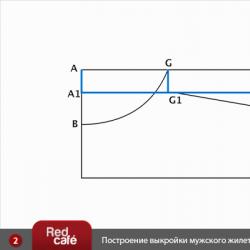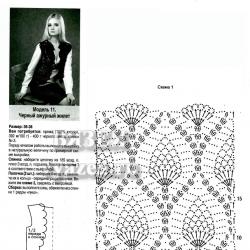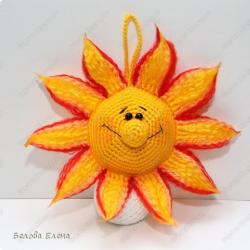Crocheted vests in the form of a circle pattern. Round vest. Description of a vest with a hood for beginners
A stylish crocheted vest has not left fashion shows for many years now! Light, airy and romantic, it will brighten up any girl, regardless of her figure, height or leg length! Today we will find out how to knit a fashionable sleeveless vest with your own hands in just a few evenings. Even if you have just recently mastered the crochet hook, do not be afraid: thanks to our descriptions, diagrams and patterns, you will easily cope with the task!
Simple openwork hooded vest for beginners
To knit a long vest for women with your own hands we will need:
- yarn (57% mohair, 43% microfiber, 200 meters per 50 grams), about 4 (5) 6 skeins;
- hook No. 4.5;
- circular knitting needles No. 5.5;
- clasp.
Finished product dimensions: 36-38 (40-42) 44-46
Basic unit: p.kr. 9 + 7. We knit following cx. 1. We start each row with loops before rap., repeat. rap., zak. loops after rap.. We will need to knit 1 x 1-8 pp., after which we will repeat 3-8 pp.
Starting from the second row we knit with. s n. for v. p. of the previous row.
Sirloin knot: p. cr. 3 + 1. Knit as basic. knot., but adhering to scheme 2: 1 x 1-3 pp., after which we repeat 2 and 3 pp..
Rubber band: alternate 2 liters. p. and 2 i. P..
Knitting density: basic knot 18 p. x 5.5 r. = 10 x 10 cm, fillet knot. 18 p. x 8 r. = 10 x 10 cm.
Important! Pay attention to the arrows on the pattern: follow the indicated knitting direction.
Patterns, diagrams and symbols:
Description of a vest with a hood for beginners
Back
Using a hook, we make a chain of 88 (97) 106 v. p. + 3 v. p.p., after which we knit the base. knot to a workpiece height of 54.5 cm (about 30 rubles), where we switch to fillet knitting.
Having knitted another 5 cm in this way - 4 r., (7.5 cm - 6 r.), 10 cm - 8 r., we leave 10 (12) 14 p. for each shoulder bevel on both sides. sl. R. 1 x 10 (12) 14 and 1 x 9 (10) 11 p. We finish knitting at high. 3.5 cm (3 rubles).
Left shelf
Using a hook, we make a chain of 70 (74) 79 v. p. + 3 v. p.p. and continue further basic. knot.. For size 40-42, start with the stitch before the rap., knit 8 rap., end with the last one. diagram 1. After 54.5 cm (about 30 rubles) from the set, we begin working with fillet. On the right we make a bevel for the shoulder in the same way as we did earlier on the back.
At the beginning of the fillet, (at a fillet height of 2.5 cm - 2 rubles), at a fillet height of 5 cm - 4 rubles. leave 12 (12) 13 p. for the neckline on the left and in each. R. 1 x 10, 2 x 8, 1 x 2 and 1 x 1 p.. We complete knitting when the back height is reached.
Right shelf
We knit symmetrically with the left.
Working on the hood
Using a hook, we collect a chain of 157 v. p. + 3 v. p.p. and knit with a fillet knot.. Having knitted 1 p. from the set, leave 2 points for rounding on both sides and in each. R. 1 x 2, 2 x 3 and 2 x 4 p. = 121 p.
Knitting 16 cm = 13 r. from the set, leave 2 stitches for bevels on the sides and in each. R. 2 x 2 p.. Finish knitting after 20 cm = 16 r. from the set.
Assembling a vest with a hood
We make seams along the shoulders, after that we work with the hood: we make a seam, sew the part to the neckline, following the instructions on the pattern. After this, we continue to work on the hood: we tie its edge together with the edges of the shelves 1 r. With. without n., at the same time, to give shape, we perform 3 s in the corners. without n. in 1 p. of the base.
For the armhole straps, we cast on with circular knitting needles on both sides of the shoulder seam for 16 (18) 20 cm 52 (60) 68 p. and knit between the edge elastic, while in the first row we evenly decrease 4 p. = 48 (56) 64 p.. Having knitted the strips to a height of 6 cm, close all the loops according to the pattern and sew the product on the sides, complete the assembly by sewing the strips - a stylish vest for women, knitted by yourself, is ready!
Stylish vest made of thick yarn: video master class
Do-it-yourself openwork long women's vest
To crochet a vest for women we will need:
- yarn (100% cotton, 124 meters per 50 grams), 6 (7) 7 skeins;
- hook No. 3.5.
Finished product sizes: 36-38, 40-42, 44-46 (German size chart).
Knitting density: 22 p. s n. x 7 rub. = 10 x 10 cm.
We stick to the diagram and pattern
Women's crochet vest: description for beginners
Back
We use a hook to make a chain of 104 (112) 128 v. p.. We knit further according to the diagram until the height reaches 54 cm, after which we cast on 48 ins on both sides. p. for sleeves and continue to perform the pattern on all eyelets.
Having knitted up to 78 (79) 80 cm, we finish knitting.
Left shelf
We crochet a chain of 40 (48) 56 chains. etc. and work according to the diagram until the workpiece is 48 cm in height.
Neck
From the side of the neck we make decreases.
1 p.: p. without n. in the last n. at the neck.
2 p.: 3 v. p., 1 p. s n. in the next p., zak. row in a pattern.
3 p.: 1 s. without n. in the last With. s n. at the neck.
Repeat 1-3 pp. through each 5 (7) 7 r. – 4 (3) 3 times.
At the same time, after knitting 54 cm, we cast on 48 ins. p. for the sleeve and knit new loops (see diagram).
Having knitted to a height of 78 (79) 80 cm, we complete the work.
Right shelf
Knitted symmetrically to the left.
Assembly and strapping
Sew the shoulders, sides and sleeves.
We tie the shelves, neckline and sleeves with the 5th row of the pattern and the knitted vest with your own hands is ready.
Sleeveless Vest with Hood for Beginners
For knitting a sleeveless vest with your own hands we will need:
- yarn (50% wool, 50% acrylic, 250 meters per 100 grams), about 3 skeins;
- hook number 3.
Finished product size: 38.
Important! Follow the directions in the diagram and pattern!
Description of women's sleeveless vest with hood
Back
Using a crochet hook, we make a chain of 74 v. p., knit 11 rr. according to cx. 1 (even pp. – front relief columns, odd – purl stitches). Next we knit with. without n. with decreases for fitting according to the pattern.
Having knitted 36 cm from the set, we knit the armholes, and after another 20 cm – the neckline and shoulder bevel.
Left shelf
We knit according to cx. 2. After 36 cm we knit the armhole of the sleeve. Having knitted 58 cm from the set, we begin knitting the neckline, and after another 5 cm - the shoulder bevel.
Right shelf
Mirror left.
Assembly
We sew the product at the shoulders and sides, along the neckline of the back and the front, we begin work on the hood with the pattern according to cx. 3. Having knitted 31 cm, we make a bevel for the hood. We finish knitting 39 cm from the set, after which we perform the final top seam.
We tie the bottom of the vest for women, the shelves and the hood in 1 row with. without n. and 1 row of chain stitch.
The hand-crocheted vest is ready!
Crochet vest: video instructions
Airy summer sleeveless vest for women
To crochet a vest, we need:
- yarn (80% viscose, 20% polyester, 75 meters per 25 grams), about 12 skeins;
- hook No. 4.5;
- 1 button.
Finished product size: 36-40.
Openwork pattern of arches for 16 stitches: knitted according to the pattern, the work is turned according to the instructions.
Repeat 16 p. rap. and 1-3 pp..
Pico: *ss. in the first s. without n. previous r., 3rd c. p., 1 ss. back to first c. p., skip 1 s. without n. previous r.*, from * to *.
Knitting density: 24 p. x 9 r. = 10 x 10 cm.
Scheme and pattern
Sleeveless vest for women: description
Back
We crochet a chain of 119 v. p. + 2 v. p.p. and knit an openwork pattern of arches, starting from arrow A. After 20 cm from the set, leave 18 p. on both sides for the armholes.
Having knitted a total of 24 cm from the armholes, we finish knitting.
Right shelf
After 23 cm from the set, we leave it on the right for the neckline in each r. 1 x 4, 1 x 3, 2 x 2 and 2 x 1 p..
Having knitted 22 cm from the neckline, we complete the work.
Left shelf
Symmetrically to the right.
Assembly
We slightly moisten the components of the sleeveless vest, straighten them according to the pattern and let them dry completely, after which we sew the shoulder and side seams. Next we will need to tie the product in a circle: two rows in a circle c. without n. and one row of picot in a circle. On the right shelf we make a hole for a button by knitting 4 in. p.. Steam the seams and sew on the button. The openwork sleeveless vest is ready for the summer!
Knitting a delicate summer sleeveless vest for women
For knitting sleeveless vests we need:
- yarn (100% cotton), about 250 grams;
- hook number 2.
Size of the finished sleeveless vest, knitted by hand: 46-48.
Knitting density: 32 p. x 13 r. = 10 x 10 cm.
Schemes and pattern
Knitting sleeveless vests for women: description
Back
Using a crochet hook, we assemble a chain from the 17th century. p. + 3 v. p.p. and knit 16 repeats of the pattern according to cx. 1, after which we finish the work.
We turn the knitting and alternately knit the patterns on the side according to cx. 2.
Having knitted 42 r. inclusive, we repeat the openwork pattern from the 15th row..
At a height of 26 cm, leave 10 stitches for the holes on both sides.
When calculating decreases, we focus on the rows where we knit exclusively columns. At a height of 49 cm, to bevel the shoulder, we leave 10 stitches on both sides in each row. We complete the work at a total height of 52 cm.
Shelves
We collect a chain from the 17th century. p. + 3 v. p.p. and knit 8 repeats of the pattern according to cx. 1, we finish the work.
We turn the workpiece and alternately knit patterns from cx on the side. 2.
Having reached a height of 26 cm, we leave 10 sts for the armhole. At the same time, for the bevel of the neck we leave with the inner. side in each row 1 p.. At high. We leave 49 cm with outer. side 10 stitches in each row. At high. 52 cm we finish knitting.
Assembly
We sew the product at the shoulders and sides, leaving 12 cm on each side for cuts.
Along the edge of the neckline cut and the vertical edges of the shelves, along the edge of the armholes and slits, we knit a border according to cx. 4. We knit 8 motifs according to cx. 3 and sew them on the bottom of the sleeveless vest: 4 on the back and 2 on the shelves.
We will be glad if today's lesson is useful to you. Even loops!
Openwork vest: video MK for beginners
Selection of schemes








Small (Medium, Large, 1X and 2X)
Bust: 32 (36, 40, 44, 48)”
Bust (finished product): 36 (40, 44, 48, 52)”
Materials
Yarn RED HEART® Boutique™ “Changes™” (87% acrylic, 12% wool, 1% other, 100 g/171 m) 3 (4, 4, 5, 5) skeins, 5.5 mm circular needles, 24” and 32” long
Knitting density
17 stitches and 20 rows = 10x10 cm in stockinette stitch
Description of a knitted vest for women
Cast on 75 (85, 95, 105, 115) sts and knit in 1x1 rib rows (k1, p1) to a height of 17 (17, 18, 18, 19)” from the cast-on edge. Do not cut the thread and do not close the loops. Switch to longer knitting needles and fold the piece along the fold line (see pattern). Using a working thread, pick up 75 (85, 95, 105, 115) sts along the cast-on edge = 150 (170, 190, 210, 230) sts. Place a marker and join the knitting into a circle, knit 1 circle of knit stitches, knitting 1 p. in each loop = 300 (340, 380, 420, 460) p. In the next. in the circle, continue knitting with an elastic band 2x3 (2 knit stitches, 3 purl stitches) and after 7 (7½, 7½, 8, 8)” bind off the loops according to the pattern.
The round vest is a very simple and, at the same time, very original model. The pattern of this vest, as its name suggests, is a circle. This model has several drapery options and, depending on the fabric chosen, can be part of both an office wardrobe and casual clothing.
Round vest: choosing material and preparing for work
How to sew a round vest with your own hands?A round vest can be sewn from different medium-density fabrics, as well as from artificial suede or thick coat fabrics. You should not sew such a vest from very thin fabrics, the upper drapery of which will be too flat. If you choose a double-sided fabric, or a fabric with a fur or beautiful fleece back, the round vest can be sewn from only one piece.
In addition, you can make a double vest by cutting out two circles from fabrics that are interestingly combined with each other. The inside of the vest is visible on the top flap and, in the case of a double vest, you will have the opportunity to wear it in two ways.
In our case, an additional detail was made so that the lapel of the vest would have the right side of the same fabric. You will need a piece of fabric, the length of which is equal to the diameter of the circle you need. In our case, this diameter was 95 centimeters and 5 centimeters went to the belt (the length of which is equal to the width of the fabric).
The outer edge of the vest and the armholes are finished with bias tape cut from the same piece of fabric, but you can also buy ready-made tape, calculating the required length using the circumference formula.
Our round vest fastens with one button, but if the fabric you choose does not slip, you can do without a fastener.
So, let's sew a round vest!
Constructing a pattern
If you have such an opportunity, we recommend cutting out a test piece from an unnecessary piece of the cheapest fabric (for example, an old sheet). The main question that needs to be decided is at what level to make the armhole cuts. Depending on the width of the top, above the armholes, a round vest will drape differently on the shoulders. It also depends on the width (diameter) of the circle you choose. At a minimum, it should be equal to the chest circumference; if you need a fastener or a deeper vest wrap, you should increase the diameter of the circle.
To pattern a round vest, take two measurements:
- Back width (press your arms to your sides and measure the distance between your arms between your shoulder blades)
- Armhole height (easiest to measure using finished clothes, on average 15-20 cm)
A round vest can be cut directly onto the fabric, but you can also construct a pattern.

To do this, just draw a circle of the desired diameter (in our case, 95 centimeters). The distance between the oval armholes is equal to the width of the back, their length is the height of the armhole. Armhole width – 7-10 cm.
The armholes can be located either in the middle of the circle (then the vest will be shorter and the turn-down collar larger) or above the center. In our model, the distance from the top point of the circle to the beginning of the armhole line is 25 cm.
Uncover
Cut a 5cm strip across the entire width (150cm) of the fabric for the belt.
From the remaining cut, cut a circle by tracing the pattern, or use this option:
Fold the square in half and in half again, so that the center of the larger square is in one of the corners of the folded square. Now fold the square into a triangle again, holding the corner with your hand, which is the center (it can be pinned together with a pin).

Using a ruler or tape measure as a compass, draw a circle line from the center point. Cut the fabric along the outline.

Straighten the circle and trim the edges. In the case of a single-sided vest (made of fabric with a beautiful reverse), you need to cut out one circle.
For a fully reversible vest, cut out two complete circles.

In the case of a vest with a lining along the edge of the turn-down collar, cut out one full circle plus an additional piece that would extend one edge over the armholes and down the sides to the waistline (as shown in the photo).

From the central part remaining after the additional part, cut out bias tape. Mark several strips 3 cm wide.

Stitch along the top edges as shown in the photo. The seam line needs to be moved left or right by one row of stripes.

Cut the stitched part with a spiral, trim the seam allowances and press. Also cut out some bias tape from the scraps left over from cutting out the circle.
Sewing a vest

Fold the belt piece in half and iron it. Iron the long edges towards the center line inward. Fold inward 5 mm from each end and fold the waistband along the ironed lines, basting.

Sew close to the edge, starting at one short end, then along the entire length of the waistband and along the other end.

Finish the edges of the additional part (except for the armholes and the outer semicircle), turning it 5 mm inward and stitching close to the edge. Place the main collar piece and the additional collar piece with the wrong sides facing each other. Pin along all edges. Baste around the outer circle and armholes.

Fold the bias tape in half and iron it. Iron the long edges towards the center line inward.

Unfold the bias tape and cut at a right angle at one end. Fold this edge of the binding inward 5mm and fold it right side to the right side of the armhole, level with the bottom edge of the armhole. Baste the bias tape along the first pressed line along the entire length of the armhole. Finish the basting 1-1.5 cm further than the beginning, with an overlap.

Sew next to the basting. Take out the basting. Fold the binding up and iron the seam. Fold the binding over to the wrong side and, tucking the second edge along the ironed line, baste it to the seam allowances.

Hand sew the bias tape to the seam allowance using a blind stitch. Also apply bias tape to the second armhole and outer circle of the vest.

Try on the vest and decide on the location for the button. Make a loop on one side and sew a button on the other side of the vest.


These vest models are very feminine and beautiful. On a cool summer evening, they will not only be appropriate in your wardrobe, but will also highlight your elegance.
Openwork vest with border
A simple and elegant vest with a wavy edge around the edge.

DIMENSIONS
34/36 (40/42) 46/48YOU WILL NEED
Yarn (46% silk, 38% cotton, 16% beads; 160 m/25 g) - 325 (350) 375 g white with beads; hook number 4.BASIC PATTERN
The number of loops in the initial row is a multiple of 15 + 2. Knit according to the pattern from arrow A. Start with the loop before the repeat, repeat the repeat constantly, finish with the loop after the repeat. From the 1st to the 3rd row, knit 1 time, then repeat the 2nd and 3rd rows constantly.Attention!
The group of loops in the diagram on a gray background will be called a “fan” in the future.BORDER
Knit according to the pattern (green icons) directly along the starting row. To do this, insert a hook at arrow B and knit rows 1-4 once.KNITTING DENSITY
24 p. x 10.5 r. = 10 x 10 cm, knit with the main pattern.ATTENTION!
Knit the vest in one piece.COMPLETING OF THE WORK
Make a chain of 212 (242) 272 vp. + 2 v.p. rise and knit with the main pattern = 14 (16) 18 repeats + 1 initial and 1 final loop.After 52.5 cm = 55 rows (50.5 cm = 53 rows) 48.5 cm = 51 rows from the initial row, divide the work and mark: 1 initial loop + 4 (4) 5 repeats + 1 final loop for the right shelf, 6 (8) 8 repeats for the back and 4 (4) 5 repeats for the left shelf.
First, continue knitting the back, while in the 1st r. For armholes, leave 3 loops unknitted on both sides.
After 72 cm from the starting row, finish the work.
Next, on the last 4 (4) 5 repeats + 1 end loop, continue to knit the left front, while in the 1st row. For the armhole, leave 3 loops unknitted on the right working edge.
At the same time, to bevel the front through 52.5 cm = 55 r. from the initial row in the next front row after the 1st “fan”, before and after the 2nd and 3rd “fans” and before the 4th “fan” (after the 1st “fan”, before and after the 2nd “fan” 1st and 3rd “fans” and before the 4th “fan”) after the 1st “fan”, before and after the 2-4th “fans” and before the 5th “fan”, perform 1 tbsp. s/n less = 6 (6) 8 decreases for each row with decreases. Repeat these decreases 3 more times in every 6th row. Due to these decreases, both the neckline bevel and the armhole bevel are obtained.
Finish the work on the remaining shoulder loops at the height of the back.
Perform the right shelf on the first 4 (4) 5 repeats + 1 initial loop in a mirror image.
ASSEMBLY
Sew shoulder seams. Tie a border along the bottom edge of the vest.The edges of the shelves, including the neckline and armholes, are tied with 1 row/circular row of connecting posts.
Shrug made of squares
A voluminous jacket without fasteners is very simple to make: the motifs are collected into a rectangular fabric, which is then sewn on the sides.

YOU WILL NEED
Yarn (46% baby alpaca, 30% merino wool, 24% nylon; 240 m/50 g) - 350 g beige; hook No. 4.5.SQUARE
Knit in circular rows according to pattern 1. Make a chain of 5 vp. and close 1 connection into a ring. Art. Knit 6 rounds. according to the scheme, with each circle.r. start with the indicated number of v.p. lifting for the 1st point and finishing 1 connection. Art. in the last v.p. If necessary, switch from 1 connection. Art. to the beginning of the next lap.r.Knit all subsequent squares like the 1st square, but in the 6th round. join to the previous square. To do this, perform 2 vp, 1 tbsp at the corners. b/n around the corresponding corner arch of the previous square and 2 more vp. Along the side edges of Art. s/n connect directly to st. s/n of the previous square.
Attention!
If the corners of 4 squares are combined at once, make the 1st connection as described; for the 2nd and 3rd connections, perform 1 st. b/n in the 1st point of the connection.CURB IN CIRCULAR ROWS
The number of loops must be a multiple of 6. Crochet according to pattern 2. The points under the pattern correspond to the loops of the 6th row. square. Tie the thread at point A. Each circle.r. start with 3 ch. lifting for 1st st. s/n and loops before rapport, repeat rapport constantly, finish with loops after rapport. Circle.r. complete 1 connection Art. in the top v.p. rise. Complete the 1st and 2nd rows 1 time.KNITTING DENSITY
1 square - 14.5 x 14.5 cm;curb - 2 circles. = 2.5 cm wide.
COMPLETING OF THE WORK
Crochet 48 squares and connect them according to the pattern = 8 squares wide and 6 squares high.Fold the work in half along the top dashed line.
Sew the side seams, leaving the top 21 cm open for the armholes.
ASSEMBLY
Tie the edges of the armholes with 1 circle. “crawfish step” (= st. b/n from left to right). Tie the bottom edge with 2 circles. curb.Vest with openwork rosette
This feminine vest is crocheted using a mixed technique: the openwork rosette on the back is crocheted, and the main fabric consists of stripes crocheted on a fork.

DIMENSIONS
36/40YOU WILL NEED
Yarn (40% viscose, 30% cotton, 20% linen, 10% polyamide; 125 m/50 g) - 300 g eggplant color; hook No. 4; knitting fork 7 cm wide or adjustable; clasp with pin.KNITTING ON A FORK
Using a fork, make strips 7 cm wide and then connect the open loops on both sides. The number of loops is a multiple of 9 or 6. Using a fork, make the corresponding number of loops (detailed instructions for the basic knitting technique are available in the packaging of the knitting fork).SOCKET
Make a chain of 10 vp. and close it into a ring using 1 connection. Art. Next knit according to. pattern in circular rows. Start each round row with the initial ch. acc. diagram and complete 1 connection. Art. or 1 tbsp. with 2/n respectively in the last initial v.p.Perform 1-3 rounds once.
For clarity, the diagram shows a connection with a strip connected to the plug.
KNITTING DENSITY
Rosette diameter = 16 cm;strip width with 1 row of v.p. arches on both sides = approximately 9 cm.
The dimensions on the pattern are obtained by measuring the model.
COMPLETING OF THE WORK
Make a socket.For the 1st stripe, make 216 loops and close them into a ring using 1 connection. Art. Connect the strip with the right side to the socket; to do this, knit * 9 loops together with 1 tbsp. b/n, perform 5 vp, 1 tbsp. b/n in the arch v.p. sockets, 5 v.p., from * constantly repeat, while in each arch v.p. sockets make 2 x st. b/n (see diagram) = 24 groups of loops. Finish this and all subsequent circular rows with 1 connection. Art.
Connect the left side of the strip; to do this, knit * 3 loops together with 1 tbsp. b/n, 5 ch, from * constantly repeat = 72 groups of loops.
Work the 2nd strip like the 1st, and connect both sides like the left side of the 1st strip = 72 groups of loops. Then connect the 2nd strip with the right side to the 1st strip. To do this, perform * 1 tbsp. b/n in 1 arch v.p. 1st stripe, 5 vp, 1 st. b/n in 1 arch v.p. 2nd strip, 5 vp, from * constantly repeat.
For the 3rd stripe, make 432 loops and close them into a ring using 1 connection. Art. Connect the right side of the strip; to do this, knit * 6 loops together with 1 tbsp. b/n, 5 ch, from * constantly repeat = 72 groups of loops.
Connect the left side, to do this, knit * 3 loops together with 1 tbsp. b/n, perform 5 ch, from * constantly repeat = 144 groups of loops.
The right side of the 3rd stripe, as described, is connected to the 2nd stripe, while through 43 groups of loops, pass 7 groups of loops for the armholes (= left armhole), connect 15 groups of loops (= shoulder line), skip 7 groups of loops ( = right armhole).
For the 4th strip, make 864 loops and close them into a ring using 1 connection. Art. Connect the right side of the strip; to do this, knit * 6 loops together with 1 tbsp. b/n, 5 ch, from * constantly repeat = 144 groups of loops.
Connect the left side, to do this, knit * 3 loops together with 1 tbsp. b/n, perform 5 ch, from * constantly repeat = 288 groups of loops. Connect the right side of the 4th strip to the 3rd strip as described.
ASSEMBLY
Tie each armhole with 1 round stitch. b/n.Openwork sleeveless vest with asymmetrical hem
It’s as simple as that: for this sleeveless vest you will need to knit a rectangular fabric with cutouts for the sleeves, and when wearing the model, you can fasten it at the chest with a figured pin or brooch.

DIMENSIONS
38/40 (42/44) 46/48YOU WILL NEED
Yarn (66% cotton, 22% polyamide, 12% yak wool; 145 m/50 g) - 450 (500) 550 g color. rosewood; hook No. 5.BASIC PATTERN
The number of loops in the initial row is a multiple of 6 + 1. Knit according to. crochet pattern pattern. Start with loops before the repeat, repeat the repeat constantly, finish with loops after the repeat. Perform rows 1-14 once, then constantly repeat rows 3-14.KNITTING DENSITY
14.5 p. initial row x 7.5 r. = 10 x 10 cm.BACK
Make a chain of 157 (181) 205 v.p. + 1 v.p. rise and knit with the main pattern = 26 (30) 44 repeats + 1 end loop.For the back, after 43 (41) 39 cm from the initial row, first continue working on the middle 10 (12) 14 repeats + 1 loop for symmetry.
After 16 (18) 20 cm from the division of work, leave the back loops.
Then continue to knit the shelves on the side loops, respectively, and after 16 (18) 20 cm from the division of work, again continue to work on all loops with a single fabric acc. pattern.
After 80 cm = 60 rows from the initial row (in the 12th row of the pattern), leave the work.
ASSEMBLY
The side of the left shelf, the initial row and the side of the right shelf in one step, tie 1 row of stitches. b/n. Put the working thread back into work, continue working with the 13th row of the pattern, and then tie the side edges and initial rows with the 13th row of the pattern.Tie the edges of the armholes with 1 round row of stitches. b/n and “crawfish step” (= art. b/n perform in the direction from left to right).






